The given figures A, B, C and D are the examples of first true land vertebrates. They are dominant in mesozoic era and belong to phylum ‘X’. Identify ‘X’ and the animals which have four chambered heart.
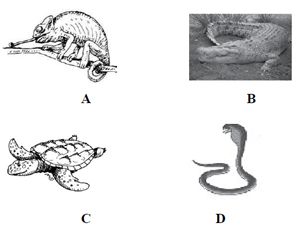
X – Reptile; B
X – Reptile; A
X – Amphibia, C
X – Pisces; D
Correct Answer :
A. X – Reptile; B
The given figures (A, B, C and D) are respectively chameleons, crocodile, turtle and cobra. Reptiles are the first true land vertebrates and dominant in Mesozoic era. They are cold blooded vertebrates. Heart in reptiles are usually three chambered but four chambered in crocodiles.
Related Questions
A student was given a specimen to identify on the basis of the characteristics given below.
(i) They are metamerically segmented.
(ii) Presence of closed circulatory system.
(iii) They have circular and longitudinal muscles for locomotion. Identify the specimen.
Prawn
Pheretima
Wuchereria
Ctenoplana
Which of the following statements (i – v) are incorrect ?
- Circulatory system in arthropods is of closed type.
- Parapodia in annelids helps in swimming.
- Phylum mollusca is the second largest animal phylum.
- Aschelminthes are dioecious.
(i) only
(iii) only
(i) and (iii)
(iii) and (iv)
Which of the following character is absent in all chordates?
Diaphragm
Coelom
Pharyngeal gill clefts
Dorsal nerve cord
The given figures (A & B) shows the germinal layer. The animals having structures shown in the figures are respectively called

diploblastic, triploblastic
triploblastic, diploblastic
diploblastic, diploblastic
triploblastic, triploblastic
Read the following statements and answer the question.
(i) They are exclusively marine, radially symmetrical, diploblastic organisms with tissue level of organisation.
(ii) Body bears eight external rows of ciliated comb plates, which help in locomotion.
(iii) Digestion is both extracellular and intracellular.
(iv) Reproduction takes place only by sexual means.
Which of the following phylum is being described by above statements?
Platyhelminthes
Arthropoda
Mollusca
Ctenophora
The transition from aquatic to terrestrial lifestyles required many adaptations in the vertebrate lineage. Which of the following is not one of those adaptations ?
Switch from gill respiration to air-breathing lungs.
Improvements in water resistance of skin.
Alteration in mode of locomotion.
Development of feathers for insulation.
The combination of a true coelom and repeating body segmentation allows the annelids (unlike the anatomically simpler worms) to do which of the following?
Attain complex body shapes and thus locomote more precisely.
Move through loose marine sediments.
Be hermaphroditic.
Inject paralytic poisons into their prey.
Refer the figures A, B, C and D given below. Which of the following options shows the correct name of the animals shown by the figures A, B, C and D ?

A – Locust, B – Scorpion, C – Prawn, D – Pila
A – Locust, B – Prawn, C – Scorpion, D – Pila
A – Locust, B – Scorpion, C – Prawn, D – Snail
A – Butterfly, B – Scorpion, C – Prawn, D – Pila
Which of the following features distinguish mammals from other vertebrates ?
Hairy skin and oviparity
Hairy skin and mammary glands
Mammary glands and teeth
Pinna and teeth
Which of the following characteristic distinguish arthropoda from annelids and molluscs ?
An external skeleton made of chitin (a polysaccharide) and protein rather than a shell made chiefly of mineral salts.
Subdivision of the legs into movable segments.
Distinct group of muscles, derived from many body segments, that move the separate parts of the exoskeleton.
All of the above
Which of the following class is being correctly described by given statements (i - iv)?
(i) All living members of this class are ectoparasites on some fishes.
(ii) They have a sucking and circular mouth without jaws.
(iii) Circulation is of closed type.
(iv) They are marine but migrate for spawning to fresh water. After spawing, within a few days they die.
Cyclostomata
Chondrichthyes
Osteichthyes
Amphibia
The given figure shows some characteristic features marked as chordates. Identify the correct labelling A,B,C and D.
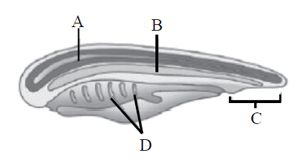
A-Notochord; B-Post-anal part; C-Gill slits; D-Nerve cord
A-Nerve cord; B-Notochord; C-Post-anal part; D-Gill slits
A-Notochord; B-Nerve cord; C-Gill slits; D-Post-anal part
A-Gill slits; B-Post-anal part; C-Nerve cord; D-Notochord
Which of the following statement(s) is/are correct regarding phylum aschelminthes?
(i) The body is circular in cross-section hence the name roundworms.
(ii) Alimentary canal is complete with a well-developed muscular pharynx.
(iii) Sexes are separate (dioecious), i.e., males and females are distinct.
(iv) Nephridia help in osmoregulation and excretion.
(i) and (ii)
(iii) and (iv)
(i), (ii) and (iii)
All of these
Match the characteristic feature/terms given in column I with the phylum to which they belongs given in column II and choose the correct option.
| Column-I | Column-II |
|---|---|
| (Characteristic feature/term) | (Phylum) |
| A. Choanocytes | I. Platyhelminthes |
| B. Cnidoblasts | II. Ctenophora |
| C. Flame cells | III. Porifera |
| D. Nephridia | IV. Coelenterata |
| E. Comb plates | V. Annelida |
A II; B I; C IV; D V; E III
A II; B IV; C I; D V; E III
A V; B I; C III; D II; E IV
A III; B IV; C I; D V; E II
Identify the figure with its correct name and phylum.

Cucumaria – Echinodermata
Ascidia – Urochordata
Balanoglossus – Hemichordata
Hirudinaria – Annelida
Identify the figure with its correct name and phylum.
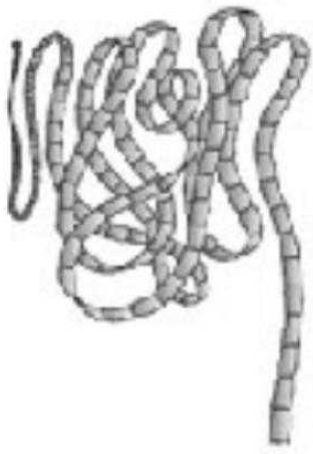
Sycon - Porifera
Aurelia - Coelenterata
Pleurobrachia - Ctenophora
Tapeworm - Platyhelminthes
The organisms attached to the substratum generally possess
one single opening to the digestive canal.
cilia on the surface to create water current.
radial symmetry.
asymmetrical body.
The given figures of animals (A & B) are distinguished on the basis of symmetry. Select the correct option which shows the type of symmetry and its description against the animals.
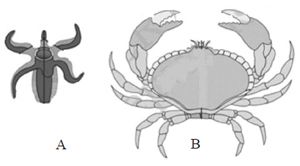
A : Biradial, organisms is divided into unequal halves by any plane through the central axis.
B: Bilateral, body is divided into equivalent right and left halves by only one plane.
A: Asymmetrical, organisms is not divided into equal halves by any plane through the central axis.
B: Radial, in which any plane passing through the central axis of the body divides the organism into two identical halves.
Refer the figures A, B and C and choose the correct option which shows animals that regulate buoyancy with the help of air bladder.
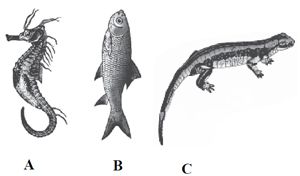
A and B
A and C
B and C
All of the above.
Identify the figures A, B and C and choose the correct option.

A - Male Ascaris, B - Hirudinaria (leech), C- Nereis
A - Female Ascaris, B - Nereis, C-Hirudinaria (leech)
A - Female Ascaris B- Hirudinaria (leech), C - Nereis
A - Male Ascaris, B - Nereis, C- Hirudinaria (leech)
Which of the following group of animals belongs to the same phylum?
Earthworm, pinworm, tapeworm
Prawn, scorpion, Locusta
Sponge, Sea anemone, starfish
Malarial parasite, Amoeba, mosquito
The figure given below shows the germinal layers marked as A, B, C and D. Identify the label showing undifferentiated layer and its location?
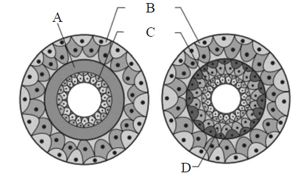
A, Between B & C
B, Between A & C
C, Between C & D
D, Between A & B
Which one of the following features is common in silverfish, scorpion, dragonfly and prawn?
Three pairs of legs and segmented body.
Chitinous cuticle and two pairs of antennae.
Jointed appendages and chitinous exoskeleton.
Cephalothorax and tracheae.
__________ is responsible for maintaining the current of water in sponge.
Osculum
Porocytes
Spongocoel
Choanocytes
In ctenophora, the body bears _______ external rows of ciliated comb plates, which help in locomotion.
five
six
seven
eight
In amphibians, respiration occurs through
gills
lungs
skin
all of these
Which one of the following categories of animals is correctly described with no single exception in it?
In chondrichthyes notochord is persistent throughout life.
All mammals are viviparous and possess diaphragm for breathing.
All sponges are marine.
All reptiles possess scales, have a three chambered heart and are cold blooded (poikilothermal).
Tracheae of cockroach and mammal are similar in having
paired nature.
non-collapsible walls.
ciliated inner lining.
origin from head.
Which of the following animal contains respiratory organs like, gills, book gills, book lungs or tracheal system?
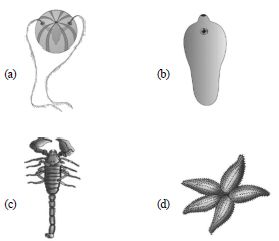
Click to check answer
Click to check answer
Click to check answer
Click to check answer
Which of the following is a correct match of a phylum with their three examples?
PlatyhelminthesPlanaria, Schistosoma, Enterobius
Mollusca Loligo, Sepia, Octopus
Porifera Spongilla, Euplectella, Pennatula
Cnidaria Bonellia, Physalia, Aurelia
